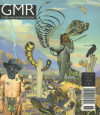Green Mountains Review – 2013
This edition of Green Mountains Review draws us to its content as soon as we see the cover. The artwork is a compelling collage done by the featured and multi-talented artist, Lou Beach. As with Beach’s work, this issue is a collage of multiple works by or about the same authors, but what you notice is the collective quality of them all, that as a whole provides more than just surface entertainment.
This edition of Green Mountains Review draws us to its content as soon as we see the cover. The artwork is a compelling collage done by the featured and multi-talented artist, Lou Beach. As with Beach’s work, this issue is a collage of multiple works by or about the same authors, but what you notice is the collective quality of them all, that as a whole provides more than just surface entertainment.
The fiction includes intriguing pieces; the styles and intents are not as clear as some readers might like, but they are intriguing nonetheless. One such piece is Luke B. Goebel’s “Apache.” This is a coming-of-age story delivered in a style that you will like, or not; its familiarity will depend on the time period when you started your literary education:
Made him want to earn his name, have-to-earn-his-goddamn-name in the racing flats, to see the leathery man with the hand saddled beside him, or not saddled but barebacking on the buck spine of his little Indian pony he rode on.
He’d been called. Be this the real desert West or a fake, be him Apache or not full, be him Corporal or not a true Corporal, Kid had been called for a reason.
Another piece that can catch your philosophical imagination is Brian Evenson’s “A Report.” This short piece of fiction can readily remind you of moments that you’ve had, wondering, “Why not me? . . . Did they make a mistake? Did they simply forget it was my turn? . . . Or, worse, is it always the same man whom they torture?”
The variety and the interest continue with Lee Ann Roripaugh’s “Breakup Blog,” Lou Beach’s “Baseball,” and Don Schwartz’s “The Ravine.” Each piece provides a different perspective on life’s events and endings that prompt both thought and memories.
There is a beautiful opportunity to see multiple facets of an artist’s life here. Eight pieces of artwork by Lou Beach demonstrate his skill as an award winning illustrator of record covers and magazines. A fascinating compliment to his fiction writing that encourages the reader to go back and see all of the works in a different light, knowing that there is more to each artist than just the one piece that’s just been read.
Similarly, there are fourteen poems by Tony Hoagland, the featured writer for this issue; poems of haunting imagery and familial reflection, including “Erroneous”:
And don’t speak, please, of the nobility of nature,
since nature has a long and terrible
record of mistakes.
We did not invent love, or joy, or dying,
but it is to our considerable credit that we
came up with lying.
But Hoagland’s poems provide a variety of insights, such as the questions in “Controlled Substances”:
Why don’t they break down my door right now
and arrest me
for using sadness as a wisdom-substitute?
the sadness that is an eventual, inevitable result
of trying to explain anything?
The poems are only the beginning. We gain our insights into Hoagland’s canon by seeing other aspects of his work and the commentaries on his talent. These insights come through three essays: Mark Halliday’s “Tony Hoagland on the Difficulty of Living,” Kenneth Hart’s “The Quieter Side of Tony Hoagland,” and Hoagland’s “How I Escaped from the Autobiographical Narrative of Crisis and Resolution and Discovered Oscar Wilde and the Tradition of Theatrical Repartee: A Tortured Tale of Psychiatry and Make-up Tips.” In his piece, Halliday writes,
The originality and value of Hoagland’s work are inseparable from his stubborn brazen directness in letting the reader know what he’s brooding about. Indeed I suspect that Hoagland’s poetry is more naked, more transparent than that of any other very good poet.
But, of course, Hoagland best summarizes his own position:
My long, slow apprenticeship as a poet was, I see now, “a misunderstanding between myself and a young person.” Thank goodness I am done with that! I’m happy now to be married to poetry for the time being, drinking even inferior champagne. And I try to remember that accuracy is not the point.
Beyond the special focus on Hoagland in this issue, there are 17 additional poets providing us with ‘fun stuff’ such as Bob Hicok’s delightful “Bumper crop”:
This child had such an easygoingmanner
oagH
on the swings, I asked him to be CEO
of the next ten minutes, he fired
the crows, promoted the mittens
There are also many, more serious works to be enjoyed. All of them commendable.
[www.greenmountainsreview.com]





